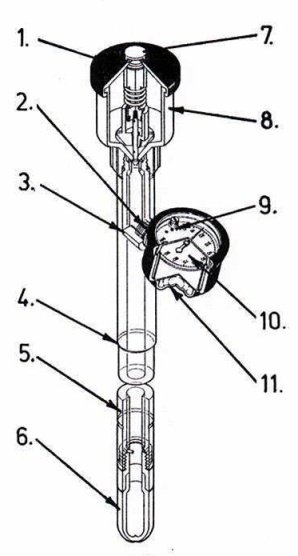Tensiometers are the only instruments that can make a direct measurement of "soil suction" - the force that plants have to overcome in order to acquire needed water, and the force that determines the moisture distribution and transport within the soil. The video demonstrates how the tensiometer is filled with deaerated water and how the tensiometer is imbedded into the soil. The demonstrated experiment introduces an easy standard mechanical tensiometer (type Soilmoisture 2710 ARL). In general, there are many different types of tensiometer from various producers, e.g. tensiometers with different lengths or microtensiometers. Nowadays, electronical pressure transducers with recording devices enabling connection to computers are widely used instead of mechanical readers.
Principle
A tensiometer consists of a tube with a porous ceramic tip on the bottom, a vacuum gauge near the top, and a sealing cap. When it is filled with deaerated water and inserted into the soil, water can move in and out of the tensiometer through the connecting pores in the tip (see Fig 1). As the soil dries and water flows out from the tensiometer, it creates a vacuum (underpressure) inside the tensiometer which is indicated on the gauge. At the moment when the created vacuum corresponds to the "soil suction", the water outflow from the tensiometer is stopped. The dial gauge reading is then a direct measure of the force required to remove water from the soil. If the soil dries further, additional water flows out until a higher vacuum level is reached. When moisture is added to the soil, the reverse process takes place. Moisture from the soil moves back into the tensiometer through the porous tip until the vacuum level is reduced to a value corresponding with the lower soil suction value. Then, the water flow stops. If enough water is added to the soil until complete saturation, the gauge reading on the tensiometer will drop to zero. As the water can flow in and out of the tube through the pores in the porous ceramic tip, the gauge reading is always in "balance" with the soil suction.
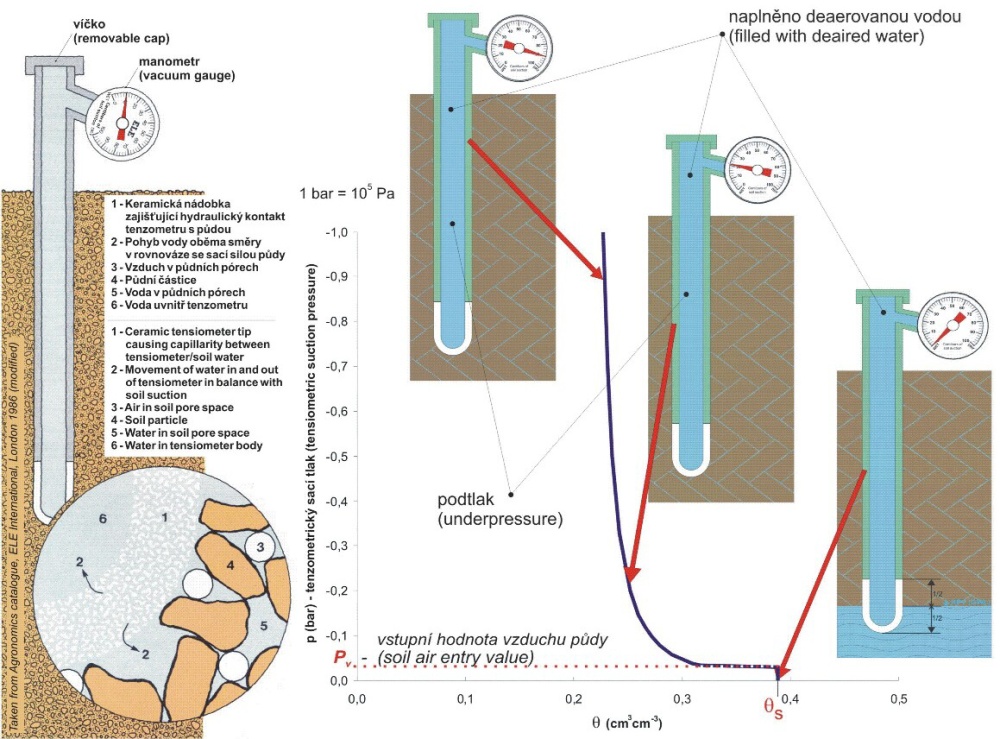
Fig 1. Measuring principle and tensiometric potential related to volumetric water content.
Materials and tools
Tensiometer (Soilmoisture Equipment Corp.), vacuum hand pump, deaerated distilled water, a bucket or big beaker, gouge auger, spatula, measuring tape, plastic wash bottle with distilled water, sampling containers and mobile balance in case of actual water content determination, notepad and pen.
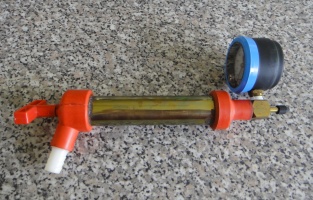


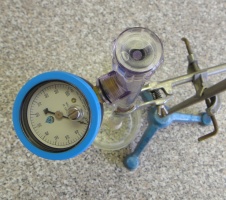
| Description of the tensiometer
1. Elastic cover closing the refilling cup. |
Important notes
- Prior saturation of the ceramic tip in distilled water is recommended as it facilitate the tensiometer filling.
- Zero point of the tensiometer: When half of the ceramic tip of filled tensiometer is submerged in water, the reading is zero. (See Fig 1, to the right.)
- When drilling the hole, taking samples for soil water content determination is recommended to see the initial water content.
- Different soil types have different response times; the response time depends also on the depth of measurement (the time needed for redistribution of infiltrated water depends on the depth).
- Air entry value of ceramic tip is about -85 kPa (= -85 centibars or -850 cm of pressure head).


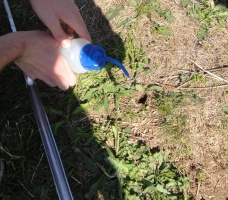
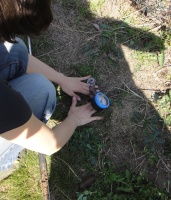
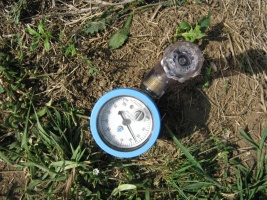
The reading of tensiometric potential is closely related to the soil water content. The dependence of soil volumetric water content on the matric potential (equal to the tensiometric when pneumatic and envelope potential components are neglected) is called the soil water retention curve, see the graph in Fig 1. The retention curve differs for different soil types. In the photo below you can see the simultaneous measurement of soil water content using a TDR sensor and tensiometric potential - both measurements are performed at the same depth. (This chapter is not focused on this topic, for more information please follow the lectures related to this topic.)
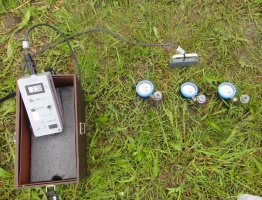
SOIL WATER POTENTIAL: A PRACTICAL APPLICATION IN THE SOIL-WATER-PLANT SYSTEM
Interpretation of tensiometer readings
Bar is an old pressure unit which has been replaced with an unit Pa: 1 bar = 100 000 Pa. However, bars are still used, especially with these types of tensiometers.
0 kPa (0 centibars)
A gauge reading of zero means the surrounding soil is completely saturated with water, regardless of the type of soil. Zero readings can be expected after heavy rain or deep irrigation. If the zero reading persists after a long period of time, there will be oxygen starvation to plant roots and development of diseases. A persistent zero reading after irrigation indicates poor drainage conditions which should be investigated and corrected.
>0-10 kPa (>0-10 centibars)
Gauge readings in the range of 0-10 cb indicated a surplus of water for plant growth. Water held by the soil in this range drains off within a few days. Persistent readings in this range indicate poor drainage conditions which should be corrected to obtain healthy plant growth.
10-20 kPa (10-20 centibars)
Gauge readings in the range of 10-20 cb indicate that there is ample moisture and also air in the soil for healthy plant growth in all types of soils. This range is often referred to as the "field capacity" range for soils, which means that the soil has reached its "capacity" and cannot hold any more water for future plant growth. When soils are at "field capacity", any additional water that is added drains out of the root zone within a day or two before it can be used by the growing plant.
If irrigation has been in process, it should be stopped when gauge drops to this level, since any further additional water will be quickly drained from the root zone and wasted, carrying with it valuable fertilizer.
- Heavy clay soils: No irrigation required at this time.
- Medium textured soils: No irrigation required at this time.
- Sandy soils: No irrigation is usually required. These soils, however, have a very limited water storage capacity and therefore soil suction values increase very rapidly as moisture is removed by the plant after soil suction values reach 15-20 cb. If water-sensitive plants, such as potatoes, are planted in coarse, sandy soils, irrigation may need to be started between 15-20 cb to allow time to apply the irrigation water before damaging stress conditions develop.
20-40 kPa (20-40 centibars)
Available moisture and aeration good for plant growth.
- Heavy clay soils: No irrigation required.
- Medium textured soils: No irrigation required.
- Sandy soils: Irrigation started for coarser sandy soils in the 20-30 cb range. For finer sandy soils in the 30-40 cb range.
40-60 kPa (40-60 centibars)
Available moisture and aeration are good for plant growth in finer textured soils.
- Heavy clay soils: No irrigation required.
- Medium textured soils: Irrigation started in this range. The finer the texture, the higher the reading before start of irrigation.
- Sandy soils: Too dry. Hot windy conditions can force soil suction to high reading quickly and damage plants.
60-80 kPa (60-80 centibars)
Readily available moisture scarce, except in heavy clay soils.
- Heavy clay soils: Start of irrigation desirable as soil suction values reach 70-80 cb.
- Medium textured soils: Too dry. Hot, windy conditions can quickly force soil suction to high reading values and can damage plants.
- Sandy soils: Too dry. Damage to plants will occur before irrigation can be applied.
References
The chapter about tensiometers was created based on the information contained on the following web page: http://www.ictinternational.com. Cited on 31 May 2010.
Cassel, D.K., Klute, A. 1986. Water Potential: Tensiometry. In Klute, A. (Ed): Methods of Soil Analysis: Part 1. Physical and Mineralogical Methods, 9. Second Edition. Madison, Wisconsin USA, American Society of Agronomy - Soil Science Society of America. p. 563-596. ISBN 0-89118-088-5.
Dirksen, Ch. (1999) Soil physics measurements. GeoEcology paperback. Catena Verlag, Reiskirchen, Germany. 154 pp. ISBN 3-923381-43-3.
Kutílek, M., Nielsen, D. (1994) Soil Hydrology. GeoEcology Textbook. Catena Verlag, Cremlingen-Destedt, Germany. 370 pp. ISBN 3-923381-26-3.











